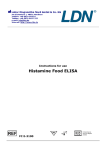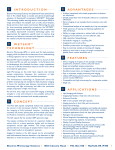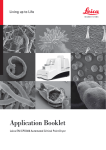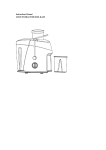Download HistaSure ™ Fish
Transcript
Instructions for use HistaSure ™ Fish FC L-3300 Rapid Test HistaSure™: Histamine Screening Test 1. Intended use The HistaSure™ assay kit is intended for the rapid screening of histamine in different kinds of samples, such as fresh fish (tuna, anchovy, mackerel, herring, salmon), canned fish, salted fish, fish in oil etc.. 2. Principle of the test After a simple and quick water extraction step, the histamine in the sample is quantitatively derivatized into N-acylhistamine and applied to the sample pad of the dipstick cassette. The amount of immunogold labelled antibody bound to the solid phase histamine is inversely proportional to the histamine concentration in the sample. The combination of the unique immunogold labeling technique and the highly specific immunoreagents provides a sensitive and flexible test system: Cut-offs can be adjusted quite easily depending on the requirements. If there is a need for cut-off adjustments please contact the manufacturer directly to get your customized solution. Histamine testing in fish is a possible control strategy that can be used by seafood processors in their HACCP program to address the hazard of scombrotoxin formation. Histamine is a product of decomposition of histidine caused by the growth of certain bacteria in seafood. The amount of the amine that forms is a function of bacterial species, the temperature and time of exposure, and may exceed 1,000 ppm (mg/kg). Fish containing high levels of histamine have been associated with many instances of poisoning commonly referred to as “scombroid poisoning,” a major health problem for consumers. Scombrotoxic fish usually contain levels of histamine in excess of 200 ppm but such fish may be randomly dispersed within a lot. For large fish, histamine is found at variable levels even within individual fish. Quality control measures designed to minimize the occurrence of scombrotoxic fish require the determination of histamine levels in the range of approximately 10 to 200 ppm. Good quality fish contain less than 10 ppm histamine, a level of 30 ppm indicates significant deterioration, and 50 ppm is considered to be evidence of definite decomposition. The defect action level (DAL), the level at which regulatory actions are taken for histamine is 50 ppm (P. L. Rogers, W. F. Staruszkiewicz, Journal of Aquatic Food Product Technology, Vol. 9 (2) 2000 p. 5 - 17.) 3. Precautions • • • • • • • Follow the test instructions and use the indicated incubation times. Deviations from the protocol may lead to inaccurate results. Do not mix reagents and solutions from different lots. Do not freeze the test kit or any single reagent. Store the unopened or opened kit dry at room temperature (18-25°C / 64-77 °F). Do not use kit components beyond the expiry dates. To avoid any cross-contamination clean pipette tips have to be used for each sample. Unused LF-cassettes (FC L-3231) must always be stored in the resealable pouch with a desiccant pack. The pouch must be resealed to protect from moisture. 4. Storage and stability The kit and single reagents should be stored dry at room temperature (18-25°C / 64-77 °F). Stability of the reagents: at room temperature until expiration date indicated on the labels. 5.1 Contents of the kit The HistaSure™ (FC L-3300) contains materials for 24 semi-quantitative determinations of histamine. FC L-3112 Acylation Caps 1 x 24 pieces ready for use FC L-3231 LF-Cassette including dipstick 24 pieces ready for use FC L-3233 Running Buffer Tubes 1 x 24 pieces ready for use, red caps! FC L-3234 Acylation Buffer Tubes 1 x 24 pieces ready for use Version: 11.0 Effective: December 04, 2013 2/4 5.2 Additional materials and equipment required but not provided with the kit Available from LDN: - 100 µl precision pipette - pipette tips (LDN catalogue# FC L-3560; 1 piece) (LDN catalogue# FC L-3561; 96 pieces) Not available from LDN: - Grinder (mill) or house hold blender - Graduated plastic cylinder (250 ml) - Distilled water - Scale ((capable of weighing 5 – 50 grams) - Funnel and filter paper (or alternatively a centrifuge) - Timer - Waterproof marker 6. Test procedure The following protocol (cut-off set at 50 ppm Histamine) is suitable for fish samples (fresh fish, canned fish, and salted fish). For fish meal and fish in oil samples please contact the manufacturer directly to obtain a specific protocol. All reagents should have room temperature prior to use (room temperature = 18-25°C / 64-77 °F). 7. 1. Weigh 10 g of fish sample, add 240 ml distilled water and homogenize for 1-2 minutes in a grinder or blender. 2. Filter the homogenate through folded filter paper (alternatively an aliquot of the homogenate can be centrifuged for 5 minutes at maximum speed). If a lipid layer forms remove it by suction! 3. Pipet 100 µl of the filtered homogenate into the Acylation Buffer Tubes. 4. Screw down the Acylation Buffer Tubes with the Acylation Caps (FC L-3112) and mix vigorously by hand. 5. Incubate the tubes for 5 minutes at room temperature. 6. Pipet 100 µl of the acylated samples into the Running Buffer Tubes (red caps!). Cap the tubes and mix gently. 7. Pipet 100 µl from the Running Buffer Tubes to the sample pad (round well) of the LF-cassette and incubate for 5 minutes at room temperature. 8. Read the results (rectangular well) visually within 2 minutes. Results and Interpretation The visual inspection of the LF-cassettes can give the following results: 2 lines or 1 line. 2 lines: The histamine concentration of the sample is below 50 ppm; the sample has passed. Example: 2 lines are visible - the sample has passed 1 line: Only the control line is visible. The histamine concentration of the sample is above 50 ppm; the sample has failed and further investigations have to be performed (e.g. quantification of Histamine with the highly-specific LDN ELISA; catalogue# FC E-3100). Example: 1 line is visible – the sample has failed Version: 11.0 Effective: December 04, 2013 3/4 8. Warranty This test kit was produced according to the latest developments in technology and subjected to stringent internal and external quality control checks. Any alteration of the test kit or the test procedure as well as the usage of reagents from different charges may have a negative influence on the test results and are therefore not covered by warranty. The manufacturer is not liable for damages occurring during transit. Customer Service For customer assistance and technical support please contact For the Americas: Rocky Mountain Diagnostics, Inc. Tel: 1-877-477-0039 Fax: 1-719-477-0307 e-mail: [email protected] World-Wide: Labor Diagnostika Nord GmbH & Co.KG Tel: +49 5921 8197 0 Fax: +49 5921 8197 222 e-mail: [email protected] Training In contrast to other available methods for the screening of Histamine in fish, the performance of the HistaSure™ is quite easy to learn and can be run by each quality control personnel. Nonetheless LDN offers training on this product and all other LDN test kits in its own laboratories or on-site. Please contact us to arrange a testified training. Symbols: Storage temperature Contains sufficient for <n> tests Manufacturer Catalogue number Batch code Expiry date Caution Content Consult instructions for use For research use only! Flow Chart 1. Extraction HistaSure™ FC L-3300 2. Filter or centrifuge (Cut-off 50 ppm) • • • • Weigh 10 grams of fish Add 240 mL of dist. water homogenize Filter the homogenate or centrifuge an aliquot of the homogenate (5 min max speed) 3. Acylation 4. Dilution • • • • Pipet 100µl extract into the Acylation Buffer tubes Screw down µ the tubes with Acylation Caps Mix vigorously and incubate for 5 min 5. Lateral Flow • or Pipet 100µl acylated extract into the Running Buffer tubes Close and mix 6. Results and Interpretation • • • Pipet 100µl diluted acylated extract on the cassette´s pad Incubate for 5 min Read the results within 2 min Version: 11.0 • • • 2 lines: histamine content< 50 ppm 1 line: histamine content > 50 ppm No line: invalid result Effective: December 04, 2013 Histamine < 50 ppm Histamine > 50 ppm 4/4






![Estrogen Receptor (ER) [SP1]](http://vs1.manualzilla.com/store/data/005885543_1-e9d75303a2a759dcb2dd4dad516aa5ce-150x150.png)







